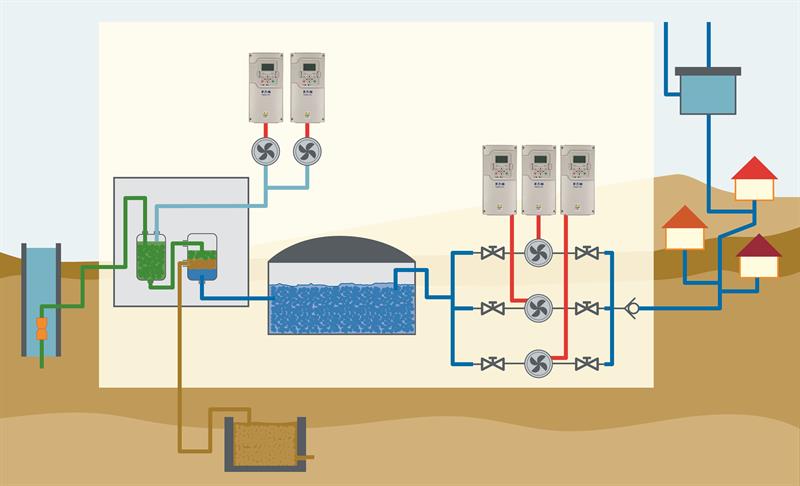Previously, the pumping station of the Zweckverband Stauden-Wasserversorgung water utility consumed between 2 million and 2.5 million kilowatt hours of energy in order to supply 37,000 people with around 2.4 million cubic metres of clean drinking water each year from a deep well. This represented an enormous cost factor for the water utility. Most of the electricity was required to drive the three clean-water pumps, which pump the treated water into the mains while also filling up three water towers.
By today’s standards, the energy consumption was considered very high, a result of the outdated drive technology, which was of a type that is still used in many waterworks today. Conventional electric motors with a capacity of 55kW each were used to drive the pumps, while the motors were switched using motor starters. The delivery rate of the system was then gradually increased by switching on the three pumps one after the other.
In order to avoid pressure surges during the start-up phase, a gate valve was used to regulate the flow rate: during start-up, the gate valve, which controlled the flow to the water supply system, initially remained closed. It only opened slowly once the pump had reached its full capacity, so that the pressure in the water supply system increased only gradually. However, this meant that the pump worked “against” the closed gate valve during start-up, so that the energy supplied by the motor could not actually be used to pump water.

From a performance point of view, this drive technology was particularly inefficient because the pumps could not operate at their optimum operating point, i.e. in the most energy-efficient manner, because the speed of the pumps could not be changed – the pumps either did not run at all or ran at full power. If no water was needed, a non-return valve prevented the water from being pushed back from the supply system. During shutdown of the pumps, the gate valves were used to reduce the backflow. Nevertheless, each shutdown resulted in increased wear on the non-return-valve.
In 2018, the water utility therefore decided to carry out a comprehensive upgrade of the pumping station, with the aim of reducing the overall life-cycle costs. Improving the energy efficiency of the system was the main priority. The contract was awarded to Aquatech AG, based in Regen, Germany. Aquatech specialises in electrical, drive and automation technology, with a focus on water supply systems, wastewater disposal and renewable energy. It is also Eaton’s solution partner for drive technology in Southeast Germany.
As a first step, Aquatech’s experts replaced the conventional electric motors with IE4 motors, which are particularly energy-efficient. Aquatech also implemented a motor-speed control system that ensures smooth start-up and shutdown and prevents the pumps from working against the valves, which would waste a lot of energy. The motor starters were replaced with PowerXL DG1 variable frequency drives from Eaton. Since Aquatech has been working with Eaton for approximately 30 years, it was familiar with all the advantages of the DG1. The PowerXL drives have been designed for motor control up to the highest efficiency class IE4. Thanks to a unique energy optimisation process, driving motors with the DG1 also consumes between 2-10% less energy compared to conventional frequency inverters.
The PowerXL drives have been designed for motor control up to the highest efficiency class IE4. Thanks to a unique energy optimisation process, driving motors with the DG1 also consumes between 2 per cent and 10 per cent less energy compared to conventional frequency inverters.
“Thanks to the integrated Ethernet IP interface, we have direct access to the individual drives that we installed at Staudenwasser,” says Markus Huber, from Aquatech’s project planning team. “This makes it easy to implement remote maintenance and thus to increase the availability of the system.” The pumping station is controlled and monitored using a PLC and a process control system to which the drives connect via Modbus TCP. All drive parameters can also be monitored via the control system.
The combination of DG1 drives with IE4 motors allows for speed-controlled operation: During start-up, the pumping capacity increases only gradually, therefore avoiding the voltage peaks and pressure surges that often plagued the old system. In fact, this has enabled the waterworks to eliminate the gate valves entirely. With the new system, sudden pressure changes in the water mains are also a thing of the past – thanks to the use of variable frequency drives, which gradually reduce the power output of the pumps. As a result, the non-return valves now close in a much more gentle manner, which translates into less wear.
What contributed most to reducing the overall operating costs was the fact that the new system allows the pumps to run at their optimum operating point of 42Hz to 53 Hz.
The process control system calculates the quantity of water required for filling the water towers and uses this information to determine the required number of pumps, taking into account the flow rate at their optimum operating point – which translates into significant energy savings compared to the old system.
What’s more, the water treatment process is now also more energy-efficient: The well water is aerated using two rotary vane compressors – the added oxygen then binds the iron and manganese particles dissolved in the water, causing them to form flakes that can be filtered out.
Aquatech replaced the conventional 5.5kWcompressor drives that were previously used for this purpose with IE4 motors, which are controlled using DG1 drives.
“All in all, the combination of IE4 motors with DG1 drives enabled us to reduce the water utility’s energy costs by about 15 per cent. At an average of 5,000 operating hours per year for each drive, this translates into major savings,” says Markus Huber.